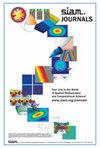Learning Regularization Parameter-Maps for Variational Image Reconstruction Using Deep Neural Networks and Algorithm Unrolling
IF 2.3
3区 数学
Q3 COMPUTER SCIENCE, ARTIFICIAL INTELLIGENCE
引用次数: 2
Abstract
SIAM Journal on Imaging Sciences, Volume 16, Issue 4, Page 2202-2246, December 2023.Abstract. We introduce a method for the fast estimation of data-adapted, spatially and temporally dependent regularization parameter-maps for variational image reconstruction, focusing on total variation (TV) minimization. The proposed approach is inspired by recent developments in algorithm unrolling using deep neural networks (NNs) and relies on two distinct subnetworks. The first subnetwork estimates the regularization parameter-map from the input data. The second subnetwork unrolls [math] iterations of an iterative algorithm which approximately solves the corresponding TV-minimization problem incorporating the previously estimated regularization parameter-map. The overall network is then trained end-to-end in a supervised learning fashion using pairs of clean and corrupted data but crucially without the need for access to labels for the optimal regularization parameter-maps. We first prove consistency of the unrolled scheme by showing that the unrolled minimizing energy functional used for the supervised learning [math]-converges, as [math] tends to infinity, to the corresponding functional that incorporates the exact solution map of the TV-minimization problem. Then, we apply and evaluate the proposed method on a variety of large-scale and dynamic imaging problems with retrospectively simulated measurement data for which the automatic computation of such regularization parameters has been so far challenging using the state-of-the-art methods: a 2D dynamic cardiac magnetic resonance imaging (MRI) reconstruction problem, a quantitative brain MRI reconstruction problem, a low-dose computed tomography problem, and a dynamic image denoising problem. The proposed method consistently improves the TV reconstructions using scalar regularization parameters, and the obtained regularization parameter-maps adapt well to imaging problems and data by leading to the preservation of detailed features. Although the choice of the regularization parameter-maps is data-driven and based on NNs, the subsequent reconstruction algorithm is interpretable since it inherits the properties (e.g., convergence guarantees) of the iterative reconstruction method from which the network is implicitly defined.
基于深度神经网络的变分图像重构正则化参数映射学习及算法展开
SIAM影像科学杂志,第16卷,第4期,2202-2246页,2023年12月。摘要。我们介绍了一种快速估计数据适应的方法,用于变分图像重建的空间和时间相关的正则化参数映射,重点是总变差(TV)最小化。所提出的方法受到使用深度神经网络(nn)的算法展开的最新发展的启发,并依赖于两个不同的子网络。第一个子网络根据输入数据估计正则化参数映射。第二个子网络展开迭代算法的[数学]迭代,该迭代算法近似地解决了包含先前估计的正则化参数映射的相应电视最小化问题。然后,使用对干净和损坏的数据,以监督学习的方式对整个网络进行端到端训练,但至关重要的是,不需要访问最佳正则化参数映射的标签。我们首先证明了展开方案的一致性,证明了用于监督学习[数学]的展开最小化能量泛函在[数学]趋于无穷时收敛于包含电视最小化问题精确解映射的相应泛函。然后,我们应用并评估了所提出的方法在各种大规模和动态成像问题上的回顾性模拟测量数据,这些问题的自动计算正则化参数迄今为止一直具有挑战性,使用最先进的方法:二维动态心脏磁共振成像(MRI)重建问题,定量脑MRI重建问题,低剂量计算机断层扫描问题和动态图像去噪问题。该方法改进了基于标量正则化参数的电视图像重构方法,得到的正则化参数图能够很好地适应成像问题和数据,保留了细节特征。尽管正则化参数映射的选择是数据驱动的,并且基于神经网络,但后续的重构算法是可解释的,因为它继承了迭代重构方法的属性(例如收敛保证),而迭代重构方法是隐式定义网络的。
本文章由计算机程序翻译,如有差异,请以英文原文为准。
求助全文
约1分钟内获得全文
求助全文
来源期刊

SIAM Journal on Imaging Sciences
COMPUTER SCIENCE, ARTIFICIAL INTELLIGENCE-COMPUTER SCIENCE, SOFTWARE ENGINEERING
CiteScore
3.80
自引率
4.80%
发文量
58
审稿时长
>12 weeks
期刊介绍:
SIAM Journal on Imaging Sciences (SIIMS) covers all areas of imaging sciences, broadly interpreted. It includes image formation, image processing, image analysis, image interpretation and understanding, imaging-related machine learning, and inverse problems in imaging; leading to applications to diverse areas in science, medicine, engineering, and other fields. The journal’s scope is meant to be broad enough to include areas now organized under the terms image processing, image analysis, computer graphics, computer vision, visual machine learning, and visualization. Formal approaches, at the level of mathematics and/or computations, as well as state-of-the-art practical results, are expected from manuscripts published in SIIMS. SIIMS is mathematically and computationally based, and offers a unique forum to highlight the commonality of methodology, models, and algorithms among diverse application areas of imaging sciences. SIIMS provides a broad authoritative source for fundamental results in imaging sciences, with a unique combination of mathematics and applications.
SIIMS covers a broad range of areas, including but not limited to image formation, image processing, image analysis, computer graphics, computer vision, visualization, image understanding, pattern analysis, machine intelligence, remote sensing, geoscience, signal processing, medical and biomedical imaging, and seismic imaging. The fundamental mathematical theories addressing imaging problems covered by SIIMS include, but are not limited to, harmonic analysis, partial differential equations, differential geometry, numerical analysis, information theory, learning, optimization, statistics, and probability. Research papers that innovate both in the fundamentals and in the applications are especially welcome. SIIMS focuses on conceptually new ideas, methods, and fundamentals as applied to all aspects of imaging sciences.
 求助内容:
求助内容: 应助结果提醒方式:
应助结果提醒方式:


